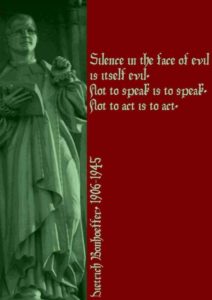Christ in Martha and Mary, Luke 10 as seen by Velasquez
The Christ in the House of Martha and Mary, an episode of Luke 10, painted by Diego Velasquez, 17th century Spanish painter
Luke 10:38-42
The Gospel in an inn kitchen in 17th century Spain
 The painting, measuring approximately 1m by 60 cm, is on display at the National Gallery in London. It dates from 1618. Velasquez was 19 years old.
The painting, measuring approximately 1m by 60 cm, is on display at the National Gallery in London. It dates from 1618. Velasquez was 19 years old.
It represents an episode of the Gospel, in the background of a scene from an inn kitchen in Spain in the 17th century.
The small painting in the large painting: Jesus on a visit
 At the top right of the image: a small table framed by
At the top right of the image: a small table framed by
black is reflected in the large board.
This small frame represents the biblical scene of Jesus’ visit to Martha and Mary.
It’s an image reversed by a mirror.
We see Jesus’ left hand and not the right hand pointing at Mary and Martha
The painter wanted to include the biblical scene in a painting representing the kitchen of a 17th century Spanish inn.
Two women from Seville preparing a meal.
 The link between the scene of the inn and the biblical scene is made by the finger of the old servant.
The link between the scene of the inn and the biblical scene is made by the finger of the old servant.
It refers to the painting in the background on the right. A painting reflected in a mirror
Beyond appearances
During his last journey to Jerusalem, before the cross, Jesus stopped in Bethany, in a friendly and welcoming house.
Martha, the housewife
He is always well received by the housewife. She is well named: Martha, the mistress. It is the feminine of the Aramaic word Mar, Master, as in Maranatha /Maran (our master, our Lord) atha (comes). We know the Greek equivalent, Kyrios, the master, the Lord
Marie, the passionate one
And the young sister Mary, whose name can mean “excellence”, listens to the words of Jesus with passionate interest.
Traditional symbols
According to the traditional interpretation (also expressed by the painters) Martha and Mary could symbolize active or contemplative life, the present or future world… justification by works or justification by faith.
Mary has often been made the type of worshipper, but a passive worshipper, at the feet of all wise and educated men. As for the Martha(s), their role in life would be to serve men. This approach is too abstract, too simplistic.
A liberating text
Instead, Jesus uses this episode to free both women and men.
Would the text (and its possible application) be very different if the characters were called Martin and Jean-Marie?
accurately illustrated.
 Jesus, sitting on a high chair, stands out in the shadow of a door.
Jesus, sitting on a high chair, stands out in the shadow of a door.
The vertical lines of the frame and chair and its high size give it the stature of a master.
Listening in reflection
The Lord speaks. Mary listens, sitting on the ground, with her hand under her chin, in an attitude of attentive listening. This is the classic pose of reflection.
Sitting at the feet of Jesus: learning
Not contemplative worship
Sitting at the feet of Jesus is not primarily about contemplation or worship.
Adoration is rather the position of the repentant sinful woman who weeps at Jesus’ feet (Luke 7:38).
This is not the attitude of contemplative worship that the Catholic Church (and others) later reserved for women or nuns.
Learning, learning the Word
Sitting at the feet of Jesus is the usual Jewish expression of the time. It is an active attitude. It means learning, learning the Word.
Paul was learning at Gamaliel’s feet.
Christ approves women’s education
Jesus therefore opens up to women the possibility of learning in the Word.
Paul will then have collaborators. Some will be experts in the Word as Prisca.
Not won in his time!
At that time, women were excluded from synagogue instruction.
Rabbis said that it was better to burn the Torah (the Jewish Bible) than to teach it to a woman.
But not everyone thought so. A story of the Talmud quotes a woman who listened to Rabbi Meir in the synagogue. Philo of Alexandria, a Jewish scholar speaks of a community where men and women study Torah together.
Martha, concerned about the reception
 Like the cook in Velasquez’s painting, Marthe is busy with various jobs or services. V 40.
Perhaps the preparation of a neat meal… and perhaps a little too complicated.
Like the cook in Velasquez’s painting, Marthe is busy with various jobs or services. V 40.
Perhaps the preparation of a neat meal… and perhaps a little too complicated.
But the text does not say anything specific about it
Martha is the eldest. She is concerned (v. 41) Her responsibility is to make the house work properly.
Two possible behaviors depending on the culture
Depending on the culture of the country, there are two ways of behaving.
The culture of guilt
In the culture of guilt, we realize that we have done wrong and act accordingly: we acknowledge our fault and bear the consequences. I was speeding. I admit it, I pay the fine and I lose points… Too bad for me.
The culture of shame
In the culture of shame, what matters is the right impression you give to others, especially not to lose face. Not seen, not taken.
A good impression is essential
So presenting the brand host with an excellent (and complicated?) meal in an impeccable home is essential for the brand image.
A false note would be catastrophic
And it may well happen on that very day: too much work in too little time and not enough hands to help, that’s the dilemma.
A good example of triangulation
 Instead of asking her sister directly to help her, Martha, standing up, points to Mary with a wave of her hand while declaring
Instead of asking her sister directly to help her, Martha, standing up, points to Mary with a wave of her hand while declaring
v. 40 Master, do you mind if my sister leaves me alone to serve? Why don’t you tell him to help me?
Doesn’t Marie, the youngest daughter, have a duty to help her eldest daughter? Especially since the work is urgent.
But it is quite possible that Mary was involved in the preparations before the guest arrived. And when Jesus is there, why can’t she take advantage of his presence, which is not so frequent, and listen to his words?
What bothers Marthe’s behavior
She wants to escape from anything that might cause her shame. So she tries to put the Lord on her side,… against her sister.
She no longer serves the Lord, she uses, … she,… of him.
She doesn’t even realize it… It’s her attitude that can cause a much more embarrassing shame when she’s caught in the wrong.
Let us also note the contrast between Martha who tells Jesus what to say and Mary who listens to what Jesus is saying.
Martha, a faithful disciple who is losing her footing
But let us not forget Martha’s distress either. She feels abandoned, not only by her sister but also by Jesus. She too is a faithful disciple who receives Jesus as best she can.
Jesus will not tell Mary to help her sister
Jesus answered him:
he raises his hand to indicate his refusal
 V 41 Martha, Martha:
V 41 Martha, Martha:
by repeating the first name, the Lord expresses his dissatisfaction with Martha’s words.
He doesn’t answer what she asks.
So Jesus will not tell Mary to help her sister.
Jesus’ raised hand is also a gesture of blessing towards Mary’s attitude
The only thing necessary
He insists on what is essential. And the only thing necessary is to accept the message of the kingdom of God. It is loving God enough to be open, receptive to his words. It is to receive the Lord, to receive Him well, to welcome Him in the right way. It is the openness of heart that Mary manifests by sitting at the feet of Jesus, it is her receptivity to hear and meditate on the words of eternal life.
Before Jesus’ last journey to the cross
Jesus is on his way to Jerusalem, the last journey before the cross. The time to spend with the two sisters is limited. He would therefore like them to make the most of intimate moments like this.
A detour through the Old Testament with Luke the historian
To go further, in the profound sense of the story, let us take a detour with Luke the historian through the Old Testament. Let’s try to recognize his intention
Luke does not recount the events of his gospel as they unfold, but he classifies them according to a deliberate intention.
A journey on the model of the Exodus
Jesus’ journey to Jerusalem is modelled on the Exodus, Moses’ journey to the promised land.
Luke 9. 30-31
During the transfiguration, two men were talking with him: Moses and Elijah, who shone with glory. They were talking about how Jesus would end his mission by dying in Jerusalem.
9.51
When the time approached when Jesus was to be taken from this world, he decided resolutely to go to Jerusalem
Those who obey God’s law enter the promised land. Likewise, one enters the kingdom of God, into eternal life, by following the Word of Christ.
The accounts of the central part of his Gospel from chapter 10 onwards are practical applications of the legislative commandments of Deuteronomy.
Listening to the Word and the meaning of the manna story
Luke links the episode with Martha and Mary, especially Luke 10:39 (Mary’s listening to the Word) to the meaning of the manna account in Deuteronomy 8:3
and he fed you with this manna that you didn’t know and that your ancestors hadn’t known. In this way, he wanted to teach you that man does not only live on bread, but also on every word spoken by the Lord.
True disciples are nourished by the word of Jesus, because it is the word of God.
This Word with the promise of eternal life is offered to those who, like Mary, sit at Jesus’ feet.
To love God is therefore like Mary, to listen to the word of her Messiah in order to know it better and also to put it into practice.
An analysis that favours listening
 Bare walls, a hard chair.
Bare walls, a hard chair.
A single light spot: a simple earthenware jug placed on a coffee table without ornaments.
It is a water pot, the most humble of liquids.
Mary, listening to Jesus’ instruction, does not need anything else.
Mary chose the right part v. 42
This good choice is also that of the psalmist of Ps 73
V.26. God remains my rock, my precious possession forever…
V. 28 My happiness is to be always close to God. Yes, I have placed my safe refuge in the Lord, in the Lord, and I will tell of his works.
Mary puts into practice the word of Jesus of Luke 4:4, which is taken from Deuteronomy 8:3: man will not live by bread alone, but by every word that comes out of God’s mouth.
The language of the election
To talk about Mary, Jesus uses the language of election (she chose). He thus draws attention to the relationship between him, the Messiah, God’s chosen one: This is my Son, the one I have chosen. Listen to him! Listen to him! (Lk 9:35) and the chosen ones, his apostles whom he chose (6:13) and also those to whom he chose to reveal himself
My Father has given all things into my hands. No one knows who the Son is except the Father; and no one knows who the Father is except the Son and the one to whom the Son wants to reveal him. 10.22.
The true disciple practices the teaching of Christ
Jesus approves Mary because she listens to his word (v 39). The true disciple must practice the teaching of Christ in order to live To enter the kingdom of heaven, it is not enough to tell me: “Lord! Oh, my God! Oh, my God! “It is necessary to do the will of my heavenly Father (Mt 7:21f)
Painting of the moment after the crisis
Velasquez chose to paint the moment immediately following the crisis.
The old woman: the Martha who reproaches
 Her face is rough, her features severe, accentuated by the darkness. A pinched look: a wrinkled forehead, wrinkles in the corners of the lips and around the mouth.
Her face is rough, her features severe, accentuated by the darkness. A pinched look: a wrinkled forehead, wrinkles in the corners of the lips and around the mouth.
She wears austere clothes: black dress, white blouse and ruffled. The same kind of clothing and… of scarf as Lazarus’ sister
With an accusing index finger, she shows the young servant the scene that takes place in Martha and Mary’s house.
She could represent Martha, the housewife who leads her boat, …the older sister who leads her little world,…the hostess who wants everything to be perfect to receive the distinguished guest, the friend, Jesus, the Lord. The Martha who reproaches me when it doesn’t work the way she wants it to: Tell her to help me.
The young cook, the other Martha, believing herself disowned
 The young cook at the inn is a peasant woman…with hands swollen by long and hard work. She has coarse features, loose red ear, red and wet lips
The young cook at the inn is a peasant woman…with hands swollen by long and hard work. She has coarse features, loose red ear, red and wet lips
She seems ready to cry:… the red cheekbones, the mouth collapsed… The bright eyes on the edge of tears…
 She can also represent Martha,…another Martha
She can also represent Martha,…another Martha
Not the Martha, mistress of the house honoring her host and receiving approval in return…
But the Martha is in the grip of emotion…… To a certain resentment perhaps. La Marthe sure to do well but believing herself disowned by the words of Jesus
The reasonable old Martha teaches the young Martha a lesson, on the verge of crying
The old woman, Martha, her reasonable side, teaches the young Martha a lesson, on the verge of tears. She takes to witness the biblical scene that she points out with her finger with insistence…
Perhaps she reproaches him (herself) for his conduct?
Why not take an example from Mary and listen to Christ?…
How do we react to the reproaches?
How do we, the Martha of the Gospel, the young servant or ourselves react to reproaches that we think are exaggerated or unjust? The biblical text did not add a verse 43 to give the solution. It is up to each of us to think…
She would do well (I would do well) to meditate… the lesson given to Martha… Marie,… has chosen the best part… And what am I going to do?
Martha has learned her lesson
And Martha probably thought the right way. She’s learned her lesson.
At the time of the death of her brother Lazarus, she manifests, like Mary, all her trust in Jesus (John 11). And later, she exercised her talents as a good cook in a great meal given in honour of the Lord and the risen Lazarus. (John 12)
Martha… or… Mary, Mary and Martha
Martha remains Martha, the practice. But she also tries to be a little Mary, the one who loves to learn in order to know the Lord better.
Martha… or… or… Marie, Martin practices it… or….. Mario, the intellectual?
Two types of opposite people? Do they risk conflict?
Not necessarily. Each one must learn to recognize that the other has received from the Lord, his gifts and his particular call.
Not necessarily if we choose to consider the other as superior to ourselves. It’s not about denigrating yourself (I suck because I haven’t been educated). It is rather a question of recognizing the value of the other, the value of his person before God, the value of his service…
More like Martha and Mary, or Martin and Mario.
The two types of people can coexist in the family and in society and also in the Church.
They can even live together in the same person…
At times, we are rather Mary: to reflect, to learn and to progress in the understanding of the Bible, to communicate it further
At other times, it is better to be Martha who is busy in the kitchen, in the garden, with the children etc….
An old preacher said: “Mary and Martha, I love them both. Martha before the meal and Mary after!
If we feel like Martha, let us also learn something from Mary. And if we are more like Mary, we probably have lessons to learn from Martha.
C. Streng



